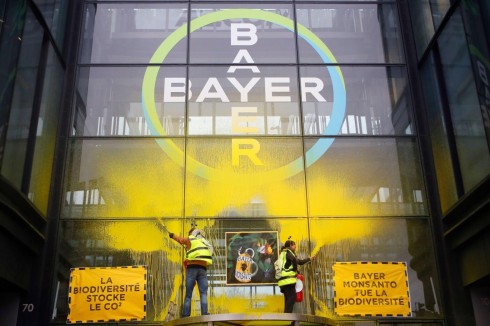In August Political Concern reported, following an alert from Richard Bruce, that the compensation claim made by Andrew Myers (below), subjected to toxic fumes in the cockpit, had prevailed in a hearing before law judge Darren Otto in the Oregon Workers Compensation Board Administrative court.
Later in the month Mike Wright covered the Myers case, adding that the union Unite is funding 10 cases due in the High Court next year to prove that toxic cabin fumes have affected many crew, pilots and passengers.

FOR YEARS, UK PILOTS HAVE BEEN FIGHTING FOR THE RECOGNITION OF ‘AEROTOXIC SYNDROME’
Aerotoxic is a term which describes acquired acute & chronic ill health caused by caused by toxic oil fumes leaking into planes’ ventilation systems from the engine and damaging the health of crew and passengers over time. A US doctor and scientists from France and Australia were the first to identify it (see Aerotoxic Syndrome: adverse health effects following exposure to jet oil mist during commercial flights.
in 2007 Capt. John Hoyte, a former BAe 146 Training Captain, who was exposed to toxic oil fumes while flying jet airliners and forced to retire due to ill health, founded the Aerotoxic Association. Its main aims and objectives are to support sufferers of Aerotoxic Syndrome and inform the public of the harm associated with poor aircraft cabin air quality.
CORONER: ‘ACTION SHOULD BE TAKEN’
So stated the senior coroner of Dorset, Sheriff Payne, in 2015. He issued a “Regulation 28 report” about the case to the Civil Aviation Authority (CAA) and British Airways (2015). In it, he stated: “In my opinion there is a risk that future deaths will occur unless action is taken. Matters of Concern are as follows…
(1) That organo-phosphate compounds are present in aircraft cabin air.
(2) That the occupants of aircraft cabins are exposed to organo-phosphate compounds with consequential damage to their health.
(3) That impairment to the health of those controlling aircraft may lead to the death of occupants.
(4) There is no real time monitoring to detect such compounds in cabin air.
(5) That no account is taken of genetic variation in the human species, such as would render individuals tolerant or intolerant of the exposure.

RECENT EVENTS
In February this year, File on Four’s Mike Powell reported that a British Airways captain issued a Mayday emergency call to the control tower at London’s Heathrow Airport. Just minutes from landing BA633 from Athens on the evening of 2 January, his co-pilot – the first officer – had slumped at the controls. They were experiencing a “fume event”, when toxic air enters the aircraft.
The BBC has seen the Air Safety Report (ASR) of that event. In it the captain notes that he experienced strong smells and then became concerned that his co-pilot wasn’t responding to questions and had started breathing rapidly. “By this time his head was dropping forward and he was not really usefully conscious. Approximately seven miles to touchdown, I immediately donned my oxygen mask and stated that I had control. [I made] a quick assessment and decision to continue to land. P2 [Pilot 2] now fully unresponsive.” This and much more was recorded in an article on the BBC website.
BA threatens staff with disciplinary action – or even the sack – if they reveal the contents of such confidential reports, but one of them has risked it, arguing that the truth needs to be known.

In March this year, an affected pilot, Len Lawrence (former British Aerospace PLC BAe146 Pilot), drew attention to Business Matters, a channel 4 exposé, (in section 2, 26.30 minutes in) on the consequences of putting organophosphates (OPs) in jet fuel. The programme note explained that organophosphates used as lubricants are known to cause permanent neurological damage in sufficient concentrations. Modern passenger jets pressurise the plane by taking in air from the engines, but in the case of turbulent airflow blowback may occur with fuel leeching forward and being sucked into the intake.
Len refers to his own case: “I was unaware that my former employer, British Aerospace (Civil Aircraft Division), had signed a secret out of court settlement over toxic oil fumes on the BAe146. The existence of the secret out of court settlement by British Aerospace was not disclosed to the House of Lords and the Australian Senate, when both were investigating toxic cabin fumes. I have sent a copy of the British Aerospace (Civil Aircraft Division), secret out of court settlement to the Under Secretary of State. The response was swift, should I require the direct assistance of the Under Secretary of State, I am to ask”.
FROM TWO AIRLINES, INVESTIGATORS, UNIONS, EU AGENCY AND CORONERS
- Pall Aerospace, in its search for a solution, is developing monitoring filters’
- EasyJet says it will trial the filters later this year. It is reported that attempts are also being made to develop engine oil that is less toxic.
- A veteran of the Air Accidents Investigation Branch estimates that fume events – of varying degrees of seriousness – happen at least twice a day worldwide. A study by the University of Kansas found that there were at least five a day in the United States alone.
- The Air Accidents Investigation Branch says it plans to publish a report on fume events later this year.
- The cabin crew union BASSA says fume events happen on average once a day on BA flights.
- European Union’s Aviation Safety Agency (EASA) told the BBC there were more than 100 serious fume incidents within its remit in each of 2017 and 2018.
- The senior coroner of Berkshire, Heidi Connor, in 2018, sent a “confidential letter of guidance” to all coroners in England and Wales. It was prompted by the inquest into the death of Matt Bass (a pilot whose parents paid for a second autopsy – and further tests – which found OPs in his blood). The BBC has seen that confidential letter. It says that should coroners be faced with a death involving a relatively young person who’s a frequent flier, who dies in unexplained or complex circumstances, they may wish to consider the need for further post mortem tests and the retention of samples.
The BBC asked to interview British Airways, EasyJet, Lufthansa, Ryanair, aircraft manufacturers Boeing, Airbus, Bombardier and the regulators, the CAA (UK), EASA (Europe) and the FAA (America). No-one was available.
They all argue that cabin air is always safe – and that it would be wrong to conclude that any illnesses or deaths of those who work on airliners are a result of working or travelling in an aircraft.
The airline industry insists there is no evidence that fume events do lasting harm, but people who work for airlines are increasingly worried that their health is being damaged and are keeping their own unofficial fume-event registers in which they record incidents.
,
Tags: Andrew Myyers, fume events, Len Lawrence, pilots, Richard Bruce
 who is working with his MP.
who is working with his MP.  In 2021, for example, farm lobby COPA-COGECA sent MEPs numerous industry-friendly amendments to the sustainable farming strategy – and suggested the removal of commitments that would make targets legally binding.
In 2021, for example, farm lobby COPA-COGECA sent MEPs numerous industry-friendly amendments to the sustainable farming strategy – and suggested the removal of commitments that would make targets legally binding.




















Recent Comments